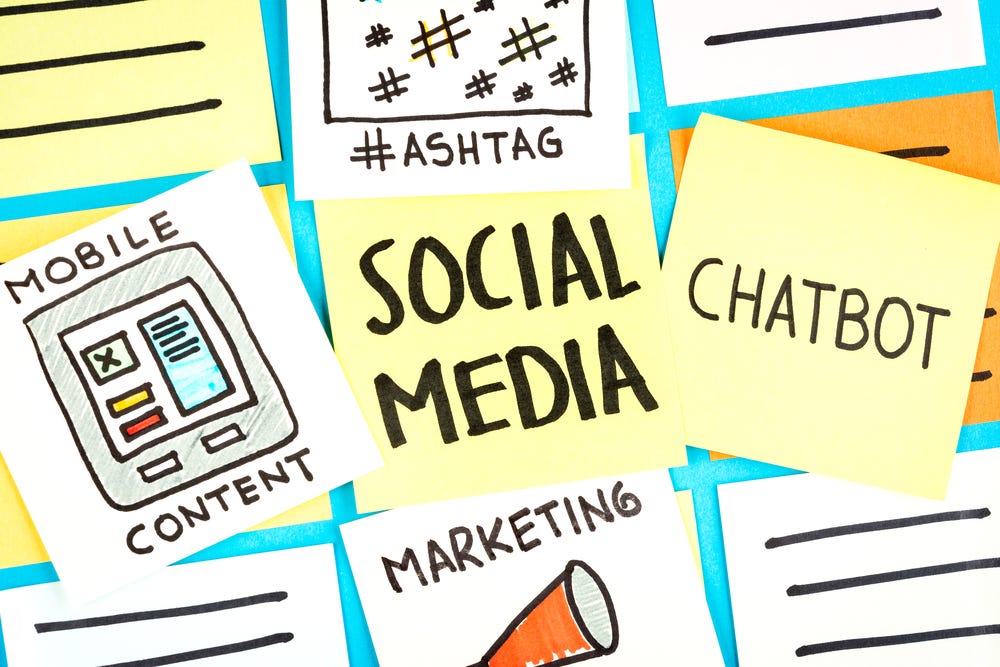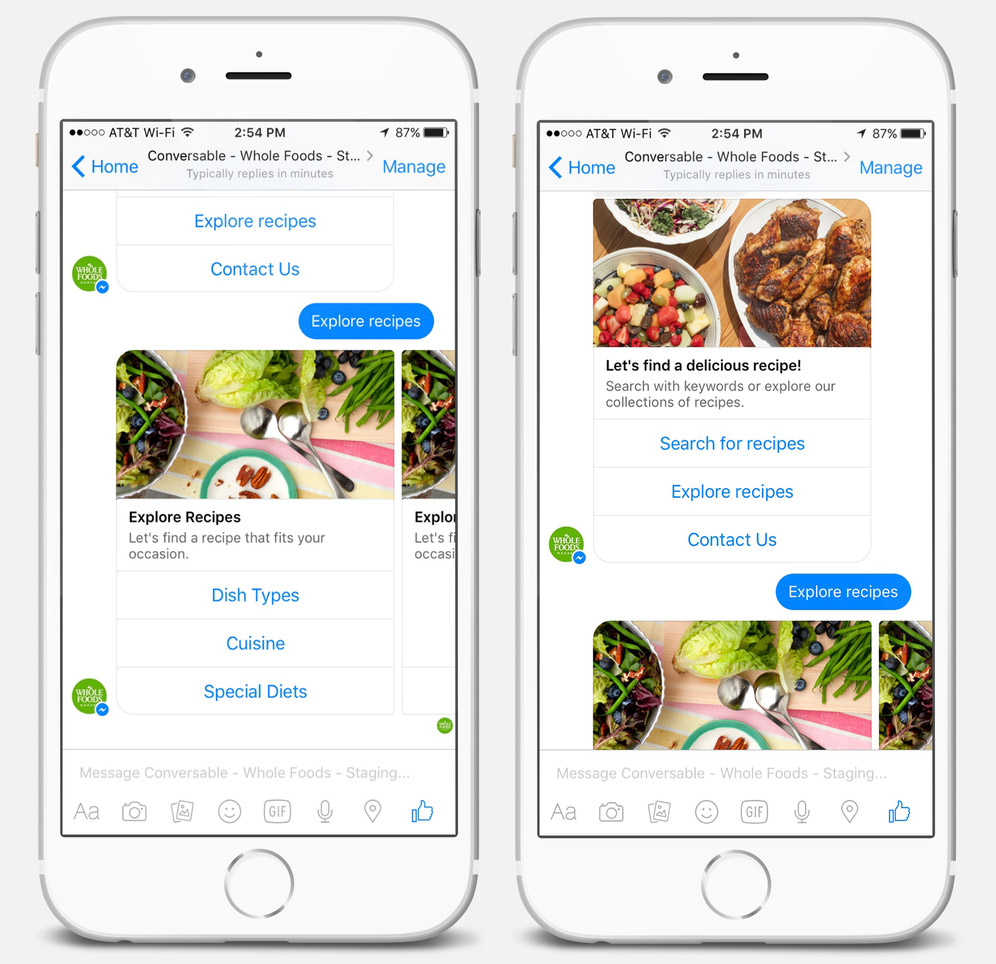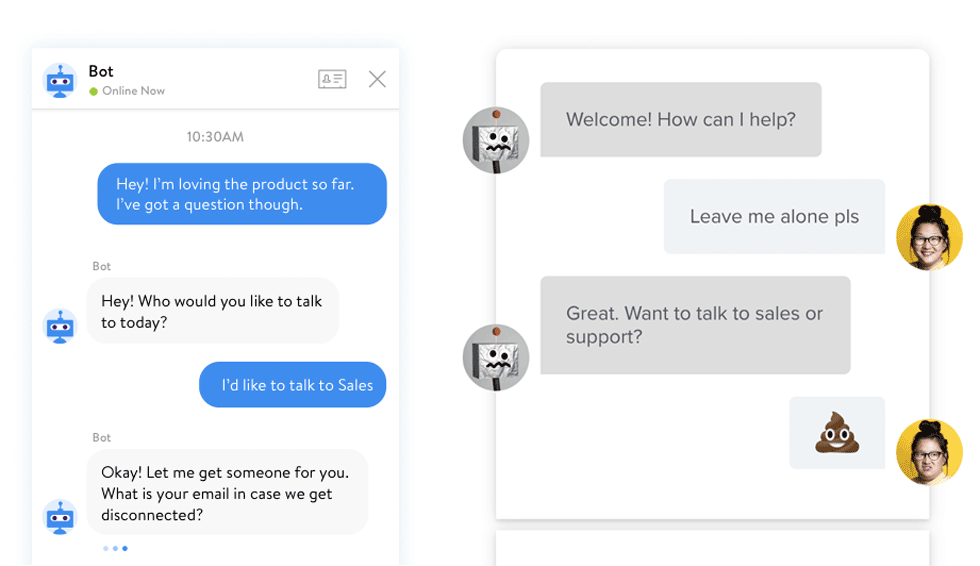The Advancement of Chatbots
What Are Chatbots?
Chatbots are programs built to automatically engage with received messages. Chatbots can be programmed to respond the same way each time, to respond differently to messages containing certain keywords and even to use machine learning to adapt their responses to fit the situation.
Chatbots leverage chat mediums like SMS text, website chat windows and social messaging services across platforms like Facebook and Twitter to receive and respond to messages.
Chatbots come in all forms. There are some fun and goofy chatbots like Cleverbot, a chatbot that chats with real people and learns as it goes.
And there are also business bots for satisfying customers. Facebook recently released a host of data proving the value of bots for business:
- 2 billion messages are sent between people and businesses monthly
- 56% of people would rather message than call customer service
- 53% of people are more likely to shop with businesses they can message
While they aren’t a new business tool, the utilization of chatbots has certainly gained momentum in the last few years. Data from Google Trends shows over the last five years, search volume around “chatbots” grew 19x as individuals and businesses began to realize their value.
The Value of Chatbots
One way to stay competitive in modern business is to automate as many of your processes as possible. Evidence of this is seen in the rise of self-checkout at grocery stores and ordering kiosks at restaurants.
In fact, Amazon just opened a store without any cashiers or self-checkouts, limiting human interactions to those only absolutely necessary.
The value in chatbots comes from their ability to automate conversations throughout your organization. Below are five key benefits businesses realize when using chatbots.
1. Save Time & Money
By automating conversations that would otherwise require an employee to answer, organizations save time and money that can then be allocated to other efforts.
Instead of having your reps spending all of their time answering inbound questions, those individuals reallocate time to proactively finding relevant conversations to join with social listening tools.
The amount of time you save increases as your inbound message quantity increases. And since Sprout Social research shows the number of social messages requiring a response from a brand increased by 18% from 2015 to 2016, you save countless hours by automating responses with a chatbot.

2. Generate Leads & Revenue
Chatbots use direct messages to gather information necessary to provide effective support. For example, asking users why they’re visiting your page is one question that is likely asked in every engagement.
Automating this initial interaction allows users to share the information needed for the agent to better serve them without requiring a human to ask for it. For example, Drift’s website chatbot qualifies prospects and gathers their email addresses so a sales rep can follow up.
This chatbot automatically delivers qualified leads to the sales organization while also fighting the fatigue caused by answering the same questions over and over. You’ll find the team is happier with more quality leads and time to spend on more meaningful work.

3. Guide Users to Better Outcomes
Customers don’t always know where to go to find the information they’re interested in. In fact, your customers may not even know what it is they’re interested in. Maybe they just heard your brand name in passing and decided to explore. By asking a series of qualifying questions, you route users to the best place for them to find the information they want.
Think through some of the questions to ask that will route your visitor to the best possible solution. These questions vary by business type, but some common ones are:
- What problem are you trying to solve?
- What are your goals?
- Where are you located?
- What department are you in?
- What industry are you in?
- Would you like personal support?
Imagine a global organization such as an airline. Between departing locations, arrival locations, potential upgrades and a myriad of places to purchase tickets, there are an almost infinite number combinations for purchase.
By personalizing the questions a chatbot asks, those airlines direct customers to the best way to buy and create a better user experience.
Social Media Chatbots

At Sprout, we believe it’s key to engage with customers where they are. And with the increase in messenger platforms for business, one of the most important channels is social.
Just look at the Google Trends report for how frequently businesses search for “messengers for business” and you’ll see a recent spike.
We additionally see the increase in messenger needs with the rise of message-based social apps like Kik, WeChat and WhatsApp. As these services become more popular for users, they emerge as important channels for business.
With over 1.3 billion users, WhatsApp recently released an application just for businesses to more effectively communicate with its users on the site. Additionally, this suite of tools includes the ability to create chatbots.
These tools are great for companies all over the world, and over 80% of small businesses in India and Brazil say WhatsApp helps them both communicate with customers and grow their business today.
While we consider these social media applications, within this guide we’ll take a deeper look at tips and strategies to create great Twitter and Facebook chatbots specifically.
If you get lost, or would like to chat with a chatbot expert, don’t hesitate to fill out the form below and someone from our team will be in touch.
Chatbot Examples
As you move forward with your plans, remember this isn’t all about you. It’s about creating a unique experience for your customers.
When deciding which chatbots to implement, it’s important to understand your audience and evaluate the communication channels you use to connect with them. This will help you prioritize which types of chatbots you should implement and what messaging you should utilize.
Here are four excellent examples of how brands are providing value to customers through chatbots:
1. Hipmunk
The pop ular travel search engine Hipmunk promises to answer travel questions and provide recommendations to travelers through its Messenger chatbot.
ular travel search engine Hipmunk promises to answer travel questions and provide recommendations to travelers through its Messenger chatbot.
 ular travel search engine Hipmunk promises to answer travel questions and provide recommendations to travelers through its Messenger chatbot.
ular travel search engine Hipmunk promises to answer travel questions and provide recommendations to travelers through its Messenger chatbot.
In its welcome message, customers can choose from travel advice, search flights and search hotels.
2. Whole Foods Market

The Whole Foods chatbot lets users search its database of recipes—a smart choice for a grocery chain.
The bot kicks off the conversation by explaining how it works. You can either search for something specific or browse through its recipe database by type of dish, cuisine or special dietary restriction.
What makes the experience even more fun is customers can mix and match text and emojis. You can enter a word using text or simply select the emoji that matches the food item you’re searching for.
The company plans to add more features, including the ability to link the chatbot to your Whole Foods account, save recipes for later and sign up for coupons.
3. 1-800-Flowers

As one of the first bots available on the Messenger Platform, 1-800-Flowers enables customers to order flowers or speak with support.
If choosing to order, customers are asked to provide the delivery address and are then given a carousel of arrangements to choose from.
Chris McCann, president of 1-800-Flowers, explained the response from customers has been positive. In a conversation with Digiday, McCann said more than 70% of the company’s bot orders are from new customers.
4. Evernote

Evernote is a great example of a company effectively leveraging chatbots for customer service. They’ve created a robust experience to collect support tickets to hand-off to internal teams for follow up.
Website Chatbots

We’ve come a long way from the days of “live chat” on websites. These days chatbots are intelligent and capable of completing a host of different tasks. Everything from booking meetings with sales reps to pushing prospects further down the funnel with engaging content can be done.
Leading the charge in chatbot innovation is Drift, which launched its conversational marketing platform less than two years ago. With Drift, businesses can connect with website visitors on a one-to-one basis, and book meetings prospects in real-time, all with the help of a chatbot.
What Can Chatbots Do?
Drift isn’t just building bots–they’re leading the conversational marketing revolution. That’s because bots have the ability to make engaging with prospects and customers as seamless as possible.
Connect With Prospects and Customers
Chatbots are smart enough to know when a visitor opens a sales email and then visits a landing page. With the help of Drift, sales and marketing teams can use chatbots to trigger conversations with prospects on their terms, when they need assistance the most.
Chatbots are smart enough to know when a visitor opens a sales email and then visits a landing page. With the help of Drift, sales and marketing teams can use chatbots to trigger conversations with prospects on their terms, when they need assistance the most.
Reduce Friction In the Sales Process
At Drift, the purpose of chatbots is to make it easier for people to buy. Chatbots can be leveraged as a tool that replaces many of the steps in the typical B2B buying process, resulting in greater sales velocity and more closed deals.
At Drift, the purpose of chatbots is to make it easier for people to buy. Chatbots can be leveraged as a tool that replaces many of the steps in the typical B2B buying process, resulting in greater sales velocity and more closed deals.
Align Your Sales and Marketing Activities
One area where Drift has seen tremendous growth is in the use of chatbots and Sequences, an email tool for sales teams. When sales reps plan and send emails using Drift Sequences, they can track all the typical email engagement metrics.
One area where Drift has seen tremendous growth is in the use of chatbots and Sequences, an email tool for sales teams. When sales reps plan and send emails using Drift Sequences, they can track all the typical email engagement metrics.
But what’s really powerful is the platform’s ability to connect prospects in an email sequence to engagement on a website. For example, a rep might send an email that a prospect doesn’t reply to right away, opting to visit the website instead for information. Once the prospect hits the website, a Drift chatbot is triggered to engage with the prospect one-to-one on the spot.
Why Would Anyone Want a Bot On Their Website?
Being able to start a conversation with a chatbot at anytime is appealing to many businesses who want to maximize engagement with website visitors. By always having someone “on call” to answer questions and book meetings with prospects, chatbots also make it easier to scale lead generation with a small team, or no team at all.
But having a chat “bot” doesn’t necessarily mean all interactions–or even a majority–are with a non-human entity. At Drift, humans staff chat most of the time, except after-hours, when the bots step in to solve problems and schedule sales meetings. This is the same approach many Drift users implement in their respective businesses. In this way, Drift makes it easier for businesses to provide 24/7 lead response times to website visitors.
Most importantly, however, today’s chatbots make it easier to get closer to customers, says Drift’s CEO, David Cancel. Cancel, a serial entrepreneur and former Chief Product Officer at Hubspot, says it best, “Bots and chat make it easier for people to buy the way they want to, when they want to–and that should be the goal of any business.”
A nice article here with some useful tips for those who are not used-to comment that frequently. Thanks for this helpful information I agree with all points you have given to us. I will follow all of them.
ReplyDeleteChatbot Company in India
Chatbot Company in Chennai
Chatbot Development Company in Chennai
Chatbot in Chennai
Chatbot Development Company in India
Thanks for sharing Information to us. If someone wants to know about,I think this is the right place for you!
ReplyDeleteChatbot development company
3D Animation services in Coimbatore
3D Animation Company